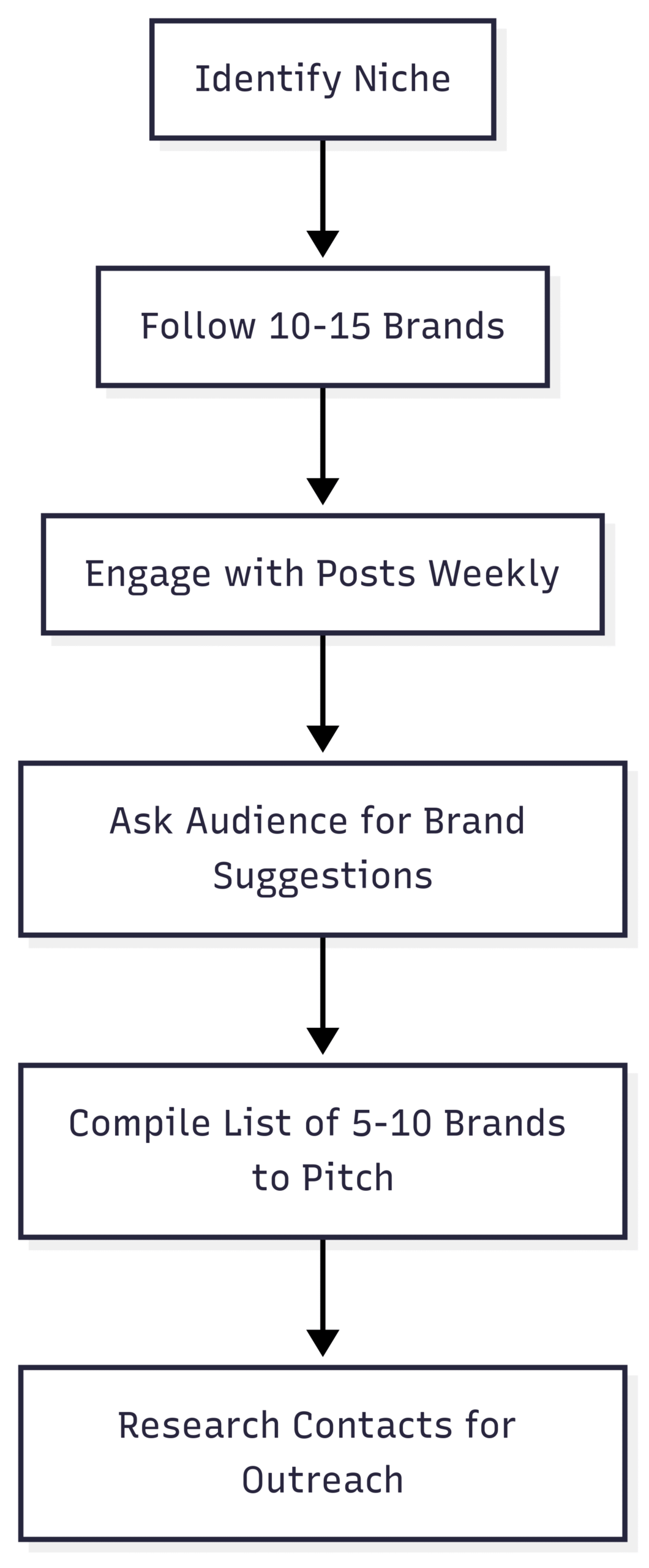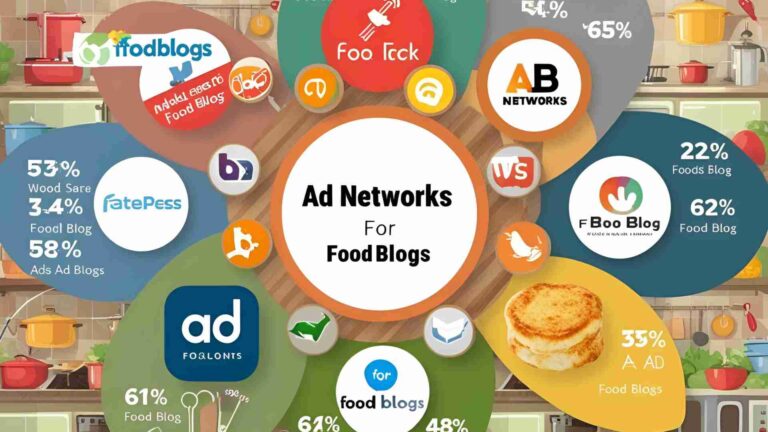5 Ways to Find Brands for Pitching
Discover 5 proven strategies to find brands for pitching as a content creator. Learn how to leverage social media, networks, and research to secure partnerships.
As a content creator, securing brand partnerships is one of the most effective ways to monetize your platform and grow your influence. Whether you’re a food blogger, a lifestyle vlogger, or a niche TikTok creator, collaborating with brands can unlock new revenue streams and elevate your content. However, the challenge lies in identifying the right brands to pitch—those that align with your niche, resonate with your audience, and are open to influencer collaborations.
Pitching to brands proactively is a powerful strategy, especially when brands may not always reach out first. According to a 2021 study by Later and Fohr, nano-influencers (those with fewer than 10,000 followers) boast the highest engagement rates, proving that even creators with smaller audiences can attract lucrative partnerships. This article outlines five actionable strategies to find brands for pitching, ensuring you connect with partners that enhance your content and appeal to your community. From leveraging social media to tapping into influencer networks, these methods will streamline your search and boost your chances of landing dream collaborations.
Why Pitching to Brands Matters
Before diving into the strategies, it’s worth understanding why pitching is critical for creators. Sponsored content is a cornerstone of influencer marketing, allowing creators to earn income while promoting products or services they genuinely believe in. Unlike waiting for brands to discover you, pitching proactively puts you in control of your partnerships. It demonstrates initiative, builds relationships, and positions you as a professional in the eyes of brand decision-makers.
Moreover, pitching allows you to target brands that align with your values and audience, ensuring authenticity in your collaborations. Authentic partnerships resonate more with followers, leading to higher engagement and trust. For food creators, for example, pitching to brands whose products you already use in your recipes can make your content feel seamless rather than promotional. With the right approach, pitching can transform your creative passion into a sustainable business.
Strategy 1: Start with What You Already Use
One of the simplest yet most effective ways to find brands for pitching is to look at the products you already incorporate into your daily life. For food content creators, this means exploring your kitchen, pantry, or grocery cart. What brands do you naturally gravitate toward? Which products do you recommend to friends or feature in your recipes? These are the brands you’re most likely to pitch successfully because your enthusiasm for their products is genuine.
How to Identify Brands in Your Niche
- Take Inventory: Make a list of brands you use regularly. For example, if you’re a baking enthusiast, note down the flour, sugar, or chocolate brands you rely on.
- Visit the Grocery Store: Wander the aisles relevant to your niche. If you specialize in vegan cooking, explore the plant-based section to discover new brands like Beyond Meat or Oatly.
- Test Before Pitching: If you spot an unfamiliar brand, try their products first. Authenticity is key—your audience will trust your recommendations more if you genuinely enjoy the product.
Why This Works
Pitching brands you already use allows you to craft authentic pitches that highlight your personal connection to their products. For instance, a food creator might write, “I’ve been using your organic olive oil in my Mediterranean recipes for years, and my audience loves the flavor it adds.” This approach not only builds trust with the brand but also ensures your sponsored content feels organic to your followers.
Pro Tip
When pitching, mention specific ways you’ve used the brand’s products in your content, even if it was unpaid. If you’ve shared a recipe featuring their ingredient on Instagram, include a link to the post in your pitch to demonstrate your existing affinity.
Strategy 2: Leverage Social Media for Brand Discovery
Social media platforms like Instagram, TikTok, and Twitter are treasure troves for finding brands to pitch. These platforms allow you to observe brand activity, engage with their content, and even crowdsource suggestions from your audience. By strategically using social media, you can identify brands that are active in your niche and open to collaborations.
Steps to Find Brands on Social Media
- Follow Relevant Brands: Start by following brands in your niche. If you’re a food creator, follow companies like Bob’s Red Mill, KitchenAid, or local artisanal brands.
- Engage Authentically: Like, comment, and share their posts to get on their radar. For example, comment on a brand’s new product launch with a thoughtful remark like, “This gluten-free flour looks perfect for my next baking tutorial!”
- Explore Similar Accounts: Social media algorithms often recommend similar brands once you follow a few. Check out these suggestions to expand your list.
- Crowdsource Ideas: Use Instagram Stories or TikTok videos to ask your audience, “What brands would you love to see me collaborate with?” Their responses can reveal brands that align with both your content and their interests.
- Monitor Brand Activity: Pay attention to brands’ posts about new products, campaigns, or influencer collaborations. This insight can help you tailor your pitch to their current priorities.
Engaging with Brand Accounts
Engaging with brands on social media isn’t just about visibility—it’s about building relationships. When you consistently interact with a brand’s content, their social media manager may take notice, making them more receptive to your pitch. Additionally, direct messaging (DM) a brand to inquire about collaboration opportunities can be effective, especially for smaller brands with accessible social media teams.
Example Workflow
Here’s a simple process to organize your social media brand search:

This workflow ensures you systematically discover and connect with brands while maintaining an authentic presence.
Why This Works
Social media offers real-time insights into a brand’s marketing strategy and influencer partnerships. By engaging proactively, you position yourself as a creator who’s already invested in their success, increasing the likelihood of a positive response to your pitch.
Strategy 3: Join Influencer Networks and Platforms
Influencer networks and marketplaces are designed to bridge the gap between creators and brands, making them an efficient way to find pitching opportunities. These platforms allow you to create a profile showcasing your niche, audience demographics, and content style, enabling brands to discover you or allowing you to apply for open campaigns.
Popular Influencer Platforms
Here’s a table of notable platforms that connect creators with brands:
| Platform | Description | Key Features | Best For |
|---|---|---|---|
| Ubiquitous | Connects creators with brands for paid campaigns across social platforms. | Campaign matching, analytics integration. | Nano to macro influencers. |
| Skeepers | Focuses on influencer and UGC campaigns with a user-friendly interface. | Campaign applications, brand discovery tools. | Mid-tier influencers. |
| The Lobby | Curates high-quality partnerships for creators in lifestyle, food, and fashion. | Personalized matching, portfolio tools. | Niche creators. |
| Collabstr | A marketplace where creators can list services and brands can browse profiles. | Direct booking, rate transparency. | Beginners and established creators. |
| Later | Offers an influencer program for creators to connect with top brands. | Analytics reports, media kit tools. | Social media-focused creators. |
How to Use Influencer Networks
- Create a Profile: Sign up and complete your profile with details about your niche, audience, and social media links. Include high-quality examples of your content.
- Browse Campaigns: Many platforms list open campaigns that you can apply for. Filter by your niche (e.g., food, wellness) to find relevant opportunities.
- Pitch Through the Platform: Some platforms allow you to send pitches directly to brands. Follow their guidelines to ensure your application stands out.
- Monitor Invitations: Brands may reach out to you based on your profile, so keep your account active and updated.
Pros and Cons
- Pros: Streamlines the brand discovery process, provides access to verified brands, and often includes tools like analytics and media kits.
- Cons: Rates on platforms may be lower than direct pitches due to pre-set campaign budgets. However, these platforms are ideal for building a portfolio and gaining experience.
Why This Works
Influencer networks reduce the time spent searching for brands by curating opportunities tailored to your niche. They also provide a professional framework for pitching, which can be especially helpful for new creators.
Strategy 4: Research Competitor Partnerships
Analyzing the brands your competitors collaborate with is a strategic way to identify pitching opportunities. Creators in your niche likely target similar audiences, so the brands they partner with are often a good fit for you too. This approach not only saves time but also confirms that the brands are open to influencer marketing.
How to Conduct Competitor Research
- Explore Social Media: Scroll through the feeds of creators in your niche on Instagram, TikTok, or YouTube. Look for posts tagged with #ad, #sponsored, or #partner.
- Check Blogs: Many bloggers, like Pinch of Yum, have dedicated pages for sponsored content. Browse these to identify brands that work with food creators.
- Note Brand Names: Create a list of brands that frequently appear in competitor collaborations. For example, a vegan creator might notice partnerships with brands like Violife or Alpro.
- Evaluate Fit: Ensure the brands align with your content and audience before adding them to your pitch list.
Tools for Competitor Analysis
- Social Blade: Tracks influencer growth and partnerships.
- HypeAuditor: Provides insights into a creator’s audience and sponsored posts.
- Manual Search: Use hashtags like #foodblogger or #veganrecipes to find creators and their brand partners.
Why This Works
Competitor research reveals brands that are already investing in influencer marketing, increasing the likelihood they’ll be receptive to your pitch. It also helps you tailor your pitch by referencing similar successful collaborations.
Strategy 5: Utilize Online Research and Direct Outreach
When all else fails, the internet is your best friend. A targeted Google search can uncover brands in your niche, even those with minimal social media presence. Additionally, direct outreach to brand representatives can open doors to partnerships that might not be advertised publicly.
Steps for Online Research
- Google Search: Use specific keywords like “vegan food brands,” “sustainable kitchen products,” or “gluten-free snacks” to find companies in your niche.
- Check Brand Websites: Look for a “Press” or “Collaborations” page on the brand’s website. These often list contact details for PR or marketing teams.
- Read Press Releases: Press releases may mention influencer campaigns or new product launches, providing a timely opportunity to pitch.
- Use LinkedIn: Search for employees with titles like “Influencer Marketing Manager” or “Social Media Coordinator” to find the right contact.
Crafting a Direct Pitch
A personalized pitch email is crucial for direct outreach. Here’s a sample structure:

Sample Pitch Email
Subject: KitchenAid X Sarah’s Food Diaries – Recipe Content Partnership
Dear [Contact Name],
I’m Sarah, a food content creator with a passion for home cooking, reaching 15,000 engaged followers on Instagram. I’ve been a loyal KitchenAid user for years, and my audience loves the recipes I create with your stand mixer.
I’d love to collaborate on a series of recipe videos showcasing your latest mixer features, driving awareness among my foodie community. My media kit and analytics are attached for your review.
Could we schedule a call to discuss potential partnership ideas?
Best,
Sarah
Pricing Guidelines
When pitching directly, you’ll need to set your rates. While there’s no universal pricing model, here are some benchmarks:
- Nano-Influencers (<10K followers): $300-$500 per 10,000 followers.
- Micro-Influencers (10K-50K followers): $500-$1,500 per post or campaign.
- Mid-Tier Influencers (50K-500K followers): $1,500-$5,000 per post or campaign.
Resources like Clara for Creators and FYPM can help you benchmark rates based on your niche and platform.
Why This Works
Online research and direct outreach allow you to target brands that may not be active on influencer platforms or social media. By personalizing your pitch and contacting the right person, you increase your chances of securing a partnership.
Additional Tips for Success
To maximize your pitching efforts, consider these supplementary strategies:
- Attend Industry Events: Networking at food expos or influencer conferences can lead to direct connections with brand representatives.
- Collaborate with Other Creators: Partnering with peers can expose you to new brands and amplify your reach.
- Participate in UGC Campaigns: Many brands run user-generated content campaigns, offering a low-barrier entry point for collaboration.
Common Mistakes to Avoid
- Generic Pitches: Avoid sending mass emails. Tailor each pitch to the brand’s products and values.
- Ignoring Audience Fit: Ensure the brand’s target audience aligns with yours to maximize engagement.
- Overlooking Media Kits: A professional media kit is essential for showcasing your value.
Conclusion
Finding brands to pitch as a content creator requires a blend of research, networking, and strategic outreach. By starting with the products you use, leveraging social media, joining influencer networks, researching competitors, and utilizing online tools, you can build a robust list of brands that align with your niche and audience. Crafting personalized pitches and maintaining authenticity will set you apart in a competitive landscape.
Whether you’re a nano-influencer or a seasoned creator, these five strategies empower you to take control of your brand partnerships. Start implementing them today, and watch your collaborations—and income—grow. For additional resources, consider joining platforms like Later’s influencer program or exploring communities like r/UGCcreators for peer support and opportunities.
Please share these 5 Ways to Find Brands for Pitching with your friends and do a comment below about your feedback.
We will meet you on next article.
Until you can read, Blogging While Working Full-Time: a Simple 13-Step Plan






